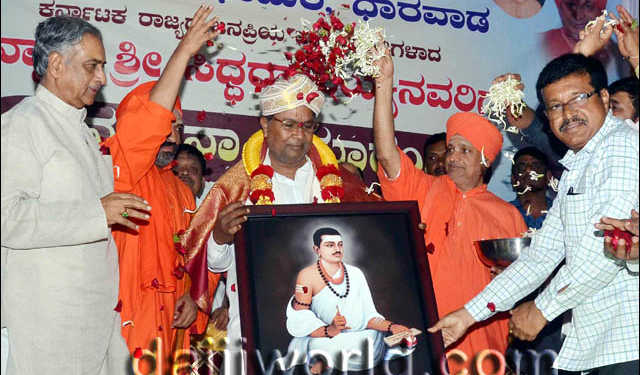In the millennia long history of Santana Dharma, great reformers have risen from time to time to tackle challenges faced by the society. Almost all reformers aimed to return the society to the path of Dharma. At a time when the concept of religion itself was lacking and Dharma was what everyone swore by, it wouldn’t be incorrect to say that none of the reformers aimed to start another ‘religion’ by actively disassociating with Sanatana Dharma.
Surely, they castigated the caste structure, the stress on rites and rituals, the inferior position of certain groups, the exploitation by other groups etc. but all they wanted was to return the society to the path of Dharma by ridding it of aberrations. This is what Gautam Buddha did in the 6th century BCE, Basaveshwara did in the 12th century, Chaitanya Mahaprabhu & Guru Nanak did in the 16th century and Sant Tukaram did in the 17th century. Unfortunately, British Colonialists and modern Indian politicians, more keen on executing their policies of divide and rule, successfully portrayed reformist movements as unique religions, different and at times incompatible with Sanatana Dharma.
Basavanna was a 12th century Bhakti reformer who tried to break the shackles of caste and gender that had begun to rigidify the Hindu society at that time. Through his poems, called Vachanaas, he sought to return the society to the path of Dharma. While he challenged and repudiated many evil practices that had crept in, his thoughts, speeches and outlook remained entirely Dharmic. He borrowed from existing ideas, refined them and made them popular among masses. The worship of Lord Shiva, in a more personal form through the Ishtalinga was a distinctive feature of Basavanna’s reforms. Over a period of time, Basavanna’s followers, called Lingayats became a strong presence in areas of modern day Karnataka and Andhra Pradesh. In Karnataka, Lingayats form nearly 17% of the population and are therefore a lucrative vote bank. BJP’s Chief Ministerial candidate in Karnataka, B S Yedyurappa, is himself a Lingayat.
The demand for recognizing Lingayats as a separate religion is an old demand and sees periodic revival during election time. The reason for this are two fold. One, it enables any party that supports the Lingayata demand to be recognized as a separate religion to win a lion’s share of Lingayat votes and Second, provisions of India’s constitution make it more lucrative for a group/community to be recognized as a minority and get dedicated funds, resources and autonomy, stemming from the minority tag. This is precisely why missionary schools have blossomed across the country while a similar counterpart for Hindus is unlikely to be seen. Karnataka is due for elections next year. Siddharamaiah led Congress has provided what can best be described as an underwhelming administration. To top it all, the juggernaut named Narendra Modi is still going strong. In all probability, assuming nothing changes drastically, Congress is all set to lose the last major state that it holds in the country.
Enter Lingayat groups. Lingayats have traditionally been Congress supporters, but many have shifted allegiance towards the BJP, if for nothing else, then for the fact that BJP has had a Lingayat face as its Chief Ministerial candidate.
Added to this is the fact that BJP has been trying to create a massive Hindu vote bank to counter the blatant minorityism practised by Congress and other regional players. Siddaramiah is perhaps the last Congress CM who carries weight, heft and is willing to do everything to prevent Karnataka being lost to the BJP. This is precisely why Congress and Siddharamaiah are willing to support the demand of a section of Lingayats for a separate religious identity. Incidentally, the Lingayat community itself is not completely bought in on the issue of separate religious identity. It would be safe to say that that political inclinations divide the community when it comes to the demand of a separate religious identity. BJP supporters are more unlikely to support it while Congress supporters are more likely to favour it.
Added to this is the Lingayat/Veershaiva complexity. While there are many that claim Veershaivaism and Lingayatism are distinct communities, the fact is that for centuries the two have been indistinguishable from each other in terms of rites, rituals and beliefs. There are people who claim that Veershaivas are merely another community among Hindus, while others claim that ‘Lingayat Dharma’ should be described as ‘Lingayat- Veershaiva Dharma’. Seers and Mathadheeshs have maintained studied silence on the issue or have gravitated towards one side. Amit Shah, during his recent visit to Karnataka also sought to speak to Mathadheeshs to clear the air on this issue. Incidentally, H D Kumaraswamy, son of H D Devegowda and the leader of JD(S) in Karnataka, that is seen as a party of the Vokkaliga community has expressed concerns that acceeding to the demand of Lingayats would open the floodgates to similar demands coming from other communities.
Whether the move works or backfires for Sidhharamaiah, only time will tell. Needless to say, the whole issue of ‘Lingayat Dharma’, while appearing as a political masterstroke, is a slippery slope that any responsible government would have done well to avoid.


































